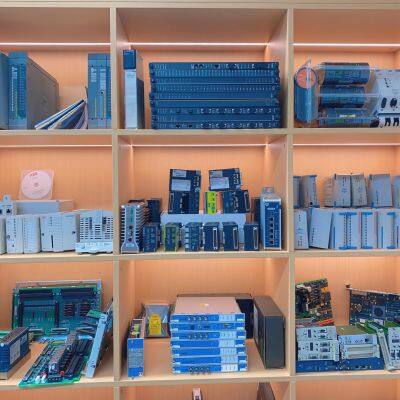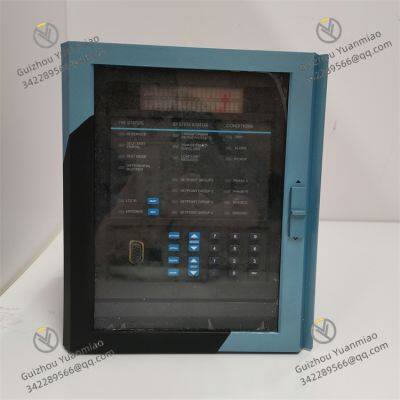Product Description
I. Product Overview
GE SR745-W2-P1-G1-HI-A-L-R-E is a high-performance generator management relay.
This relay integrates advanced technologies and high-quality components. It adopts a sophisticated signal processing circuit internally, which can quickly and accurately analyze and process various input signals. At the same time, it is equipped with reliable isolation and protection circuits, which can effectively resist the interference of the complex electromagnetic environment in the power system, prevent signal distortion and equipment damage due to abnormal conditions, and provide a solid guarantee for the stable operation of the generator. In terms of structural design, it follows the principle of compactness and practicality, with a reasonable size, which is convenient to install in various power control cabinets and can work with other power equipment to build an efficient power control system. Its shell is made of strong and durable materials, with excellent anti-vibration and anti-impact performance, which can adapt to harsh industrial environments and ensure long-term stable operation.

II. Performance Parameters
(1) Electrical Characteristics
Power Requirements: It supports a wide range of control power supplies, with DC 20-60Vdc and AC 20-48Vac (frequency 48-52Hz). This design can adapt to various common power system power configurations, ensuring stable operation under different power supply conditions, while maintaining low power consumption, which will not cause excessive burden on the power supply of the entire power system.
Input and Output Specifications: It has four isolated 4-10mA analog input and output channels, which can be used to connect various sensors and actuators to accurately collect and output analog signals. For example, it can be connected to temperature sensors, pressure sensors, etc. to obtain real-time operating data, or control the actions of actuators such as control valves. It also has seven assignable digital input channels, which can accurately collect switching signals from on-site equipment, such as the opening and closing status of circuit breakers, the on-off signals of sensors, etc.
Signal Processing Capability: Relying on advanced hardware architecture and high-performance microprocessors, it can quickly collect, analyze and convert various input signals. For the rapidly changing signals in the power system, such as the current and voltage fluctuations of the generator, it can respond quickly to ensure that the control system can make accurate decisions in a timely manner according to the actual operating status of the generator.
(2) Interface Characteristics
External Device Connection Interface: The analog signal connection adopts a high-precision, anti-interference dedicated interface, which can effectively reduce the attenuation and distortion of analog signals during transmission and ensure the accurate transmission of signals. For example, when connecting the analog signal of a temperature sensor, it can accurately transmit the temperature change signal to the inside of the relay for processing. Digital signals are connected through reliable photoelectric isolation interfaces to ensure stable transmission of digital signals without being affected by external interference. Even in complex electromagnetic environments, digital signals can be transmitted accurately to avoid signal misjudgment.
(3) Environmental Adaptability
Operating Temperature Range: It can operate stably under extreme temperature conditions from -40°C to +85°C. Whether in cold northern outdoor substations, hot southern industrial plants, or even some special high-temperature or low-temperature industrial environments, such as high-temperature areas in steel mills and low-temperature environments in cold storage, it can maintain good working performance, ensuring that the power system is not affected by temperature changes.
Humidity Adaptability: It can adapt to a non-condensing humidity environment of 0% to 95%. In coastal areas with high humidity or humid industrial production environments, it can still work normally, and will not cause short circuits of internal circuits or damage to components due to humidity problems, ensuring the stable operation of the power system under different humidity conditions.

III. Functional Features
(1) Comprehensive Generator Protection Functions
Overvoltage Protection: It monitors the generator output voltage in real time. When the voltage exceeds the set threshold, it quickly triggers the protection mechanism, cuts off the circuit or takes other protection measures to prevent the generator from damaging key components such as windings due to overvoltage. For example, when a fault occurs in the power system leading to an abnormal increase in voltage, it can act in time to protect the safety of the generator.
(2) Flexible Signal Processing and Conversion Functions
Analog Signal Processing: It integrates a high-precision A/D conversion circuit internally, which can accurately convert continuously changing analog quantities into digital quantities, facilitating processing and analysis by the control system. At the same time, it supports preprocessing operations such as filtering and amplification of analog signals to improve the quality and reliability of the signals. For example, when collecting the analog signal of a temperature sensor, filtering can remove noise interference in the signal, and amplification can enhance weak signals, making the collected data more accurately reflect the actual operating conditions.
(3) Reliable Fault Diagnosis and Self-Protection Functions
Fault Diagnosis: It is equipped with multiple sensors and monitoring circuits internally, which can monitor its own working state in real time, including power supply voltage, signal transmission quality, chip temperature, etc. Once an abnormal situation is detected, it immediately sends detailed fault alarm information to the control system through indicator lights or communication interfaces to help operation and maintenance personnel quickly locate and solve the fault. For example, when an abnormal power supply voltage is detected, it sends an alarm in time to prompt a possible power supply fault.
(4) Good System Compatibility and Expandability
Compatibility: As a member of the GE Multilin product series, it has excellent compatibility with other GE power equipment and control systems. It can be seamlessly integrated into existing power automation control systems and work with other equipment to realize the overall function of the system. For example, it can perfectly cooperate with GE's monitoring system to transmit the generator's operating data to the monitoring interface in real time, facilitating operation and maintenance personnel to monitor and manage.

IV. Installation Steps
(1) Preparation Before Installation
Appearance Inspection: Before installation, carefully inspect the appearance of the relay to ensure that there is no obvious damage, deformation or component falling off on the surface. Check whether the shell has cracks, scratches, and whether all interfaces are intact to avoid communication failures or abnormal signal transmission after installation due to appearance problems.
Interface Inspection: Focus on checking various interfaces of the relay, including analog signal interfaces, digital signal interfaces, communication interfaces, etc., to confirm that the interfaces are not damaged, not blocked by foreign objects, and the pins of the interfaces are not bent or broken, ensuring that the interfaces can normally connect to external equipment and conduct data communication.
(2) Module Installation
Positioning and Installation: Align the GE SR745-W2-P1-G1-HI-A-L-R-E relay with the reserved slot in the power control cabinet, and push it in smoothly along the guide rail until the relay is in close contact with the backplane to ensure proper installation. During the pushing process, care should be taken to avoid excessive force causing damage to the relay or insecure installation.
Fixing Operation: Use the fixing screws that come with the relay to firmly fix it on the guide rail of the control cabinet to prevent the relay from loosening due to vibration during equipment operation, which may affect signal transmission and system stability. When fixing the screws, tighten them according to the specified torque to ensure reliable fixing. At the same time, pay attention to the correct installation direction of the relay, and keep an appropriate distance from other adjacent equipment to facilitate heat dissipation and maintenance.
(3) Wiring Connection
Analog Signal Wiring: According to the interface marks of the relay and the wiring requirements of external equipment, connect the analog signal lines of external equipment to the corresponding analog input and output interfaces of the relay one by one. When connecting analog signal lines, pay special attention to the wiring order and polarity, and operate in strict accordance with the instructions. At the same time, try to shorten the length of the signal lines to reduce interference during signal transmission. For example, when connecting the analog signal line of a temperature sensor, ensure that the red wire is connected to the positive pole and the black wire is connected to the negative pole, and install the signal line as close to the equipment as possible to avoid paralleling with other high-voltage lines.
(4) Power-On Configuration and Testing
Power-On Inspection: After completing the wiring, turn on the power supply of the power control cabinet. At this time, the power indicator of the relay should be on, indicating that the relay is normally powered. Observe the state of the power indicator. If the indicator flashes or does not light up, immediately check the power connection and whether the relay is faulty.
Parameter Configuration: Configure the parameters of the relay through special programming software. According to the actual operation requirements of the power system, set the type of input and output channels, signal range, protection threshold, filtering parameters, etc. During the configuration process, carefully check each parameter to ensure that the settings are correct and in line with the actual operation of the power system.


Prosoft 5202-DFNT-MCM4 Communications Module
Emerson KJ4110X1-BA1 Programmable Logic Controller
ABB 1MRB15004R0001 Communication Module
ABB 1MRB150005R0001 Digital I/O Module
HIMA 80105 984080105 Communication Module
ABB 1MRK001967-AA Control Card
ABB 1MRB150020R1102 Ccontroller Module
ABB 1MRB150038R1 Power Supply Module
ABB 1MRB150051R1 Power Supply Module
ABB PPD513A-23-111615 magnetic excitation controller
TRICONEX Safety Instrumented System (SIS) 4351B control module
Bentley Nevada 3500/22M Transient data interface module
Bently Nevada 3500/15-05-05-00 power module
Triconex 3009 processor module
ABB GFD563A102 3BHE046836R0102 Excitation Convection Interface Module
ABB PPD117A3011 3BHE030410R3011 Excitation Controller
ABB PCD231B101 3BHE025541R0101 Excitation Unit Controller
ABB 5SHY3545L0010 3BHE009681R0101 High-Voltage Thyristor Module
 yezi
Hi there! Welcome to my shop. Let me know if you have any questions.
yezi
Hi there! Welcome to my shop. Let me know if you have any questions.





